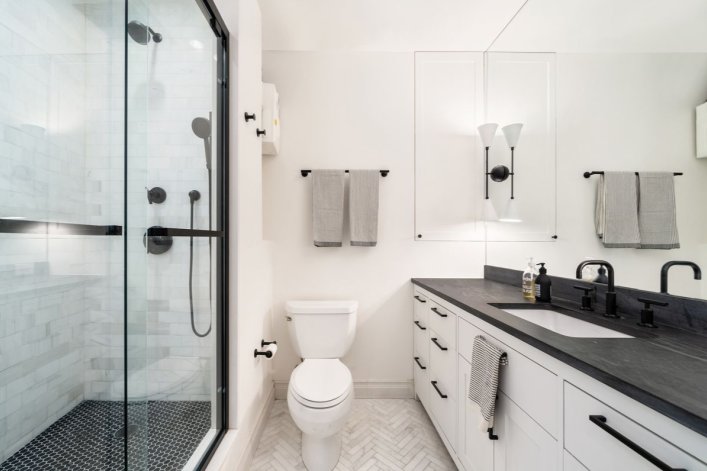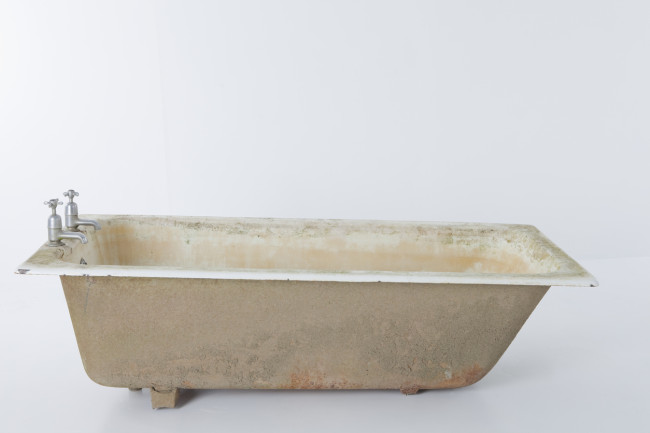Brick Underground's best advice on renovating the bathroom in your NYC apartment

A newly gut-renovated apartment in the West Village has a large black-and-white full bathroom with a walk-in shower.
Renovating a New York City bath—as small as it may be, means facing myriad decisions. Of course, you need to plan your budget, find a contractor, and shop for fixtures, tile, vanity, flooring, and a toilet—each item on this list a major treasure hunt, or chore, depending on your comfort level.
But that’s not all, not by a long shot. This is NYC, so nothing is ever easy, especially not a renovation, and especially not when you are overhauling a bathroom in an older building. There are lots of questions to address, like should you take out the tub? Install radiant heating? Split a large bath into two smaller ones?
Brick Underground has rounded up our best advice to these and many more questions, with tips from experts on what to spend on and where you can save. Read on before you tackle your dream bath renovation.
Want to know what not to skimp on when renovating your NYC bathroom? Using qualified, experienced professionals, like architects, contractors, plumbers, and electricians, may cost more than going the DIY route, but you’ll benefit from their expertise and avoid having to redo costly mistakes. It’s best to confirm that your contractor has a license issued by the Department of Consumer Affairs and is properly insured.
Spa trend is here to stay
Where else should you splurge and skimp on your urban bathroom renovation? The trend toward spa-like baths shows no sign of draining away. Fully tiled showers, hand-mounted shower heads, and thermostatic valve that allow you to pre-set the water temperature are some of the improvements you can add for spa-like touches to your bath.
Create an en suite bath
Sometimes an architect will recommend splitting a large bathroom into two smaller ones in order to create access to en suite bath via the master bedroom. It might add significantly to the resale value of an apartment, but you need to pencil it out first carefully to be sure. But you should know opinion is divided on whether an en suite is desirable, especially when it is the only bath in an apartment. Here are some arguments pro and con.
Renovation case studies
Every renovation has its own unique challenges, but there’s lots you can learn from others who have gone down that road. Brick talked to three experienced renovators on what they did learned from the process—like whether to go the budget or gut-reno route, why you should spring for quality tile, and you shouldn’t take no for an answer. (Suffice it say that all of the lessons were learned the hard way.)
Renovating in a co-op
Renovating a bath when you live in a co-op building adds a whole other layer of complexity—even when you are a long-time shareholder who sits on the board and knows the building well.
This renovator’s mistake? Not being familiar with a new management company’s rules—and prices. Here are the seven things she wishes she knew before renovating her co-op’s bath. She recommends working with someone who has done work in the building before, if possible. You’ll get someone who knows the allowed work times, use of elevator rules, and what tools they may use so as not to disrupt the neighbors.
Speak like a contractor
You might be more inclined to want to talk about rain shower panels and teak benches, but there’s a host of necessary, but not so sexy lingo you need to incorporate into your vocabulary, like grout, permits branch lines, waterproofing, and building codes. Here a contractor offers five essential areas to think about when renovating your bathroom.
Speak like a designer
A lot of owners can’t tell the difference (or didn’t know there was one) between Calacatta and Carrara marble. After all, both are classic, white Italian marbles. On average, the price per square foot for Calacatta is approximately four to six times higher than Carrara. Here’s more on how to tell the difference between Carrara and Calacatta marble.
Can I lose the tub?
You may be eyeing the space-hogging, old-fashioned tub, and looking to replace it with more modern shower. But how will that sort of renovation impact resales? Will your apartment lose value? It’s a perennial question, and to determine the answer, check out what happened with other apartments that did a similar renovation.
Reglazing vs. replacing the tub
Spraying a new topcoat on a tired tub or even old bathtub tile is a great way to make something worn look new again, and it works well on antique tubs. It’s much more cost efficient, but be warned, the smell will drive you out of your apartment for at least a day. Here’s what you need to know about this affordable but stinky bathroom upgrade, and what can wrong.
You Might Also Like



























